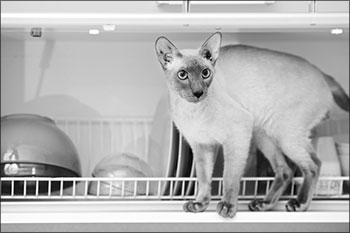Cats who counter surf during food preparation, chew on exposed electrical cords or brush up against burning candles are all at risk for burns. Pink-nosed, light-colored cats who seek sunny spots outdoors for prolonged naps are also vulnerable — another reason to keep cats inside.

288
The three main types of burns are chemical, electrical and thermal, which is caused by hot objects. First-degree burns affect the skin superficially and cause discomfort. Second degree painfully penetrates several underlying layers, and third-degree burns injure all layers of the skin and can result in shock.
“Thermal burns from going through a wash cycle in a washing machine or through the clothes dryer are some of the more common indoor injuries I have seen — and they can be fatal,” says Elisa Mazzaferro, DVM, Ph.D., ACVECC, a specialist in emergency and critical care at Cornell University Veterinary Specialists in Stamford, Conn. “Also, cats who jump on a flat-surfaced ceramic stovetop can get burns to their footpads.”
Hiding Pain. Don’t be fooled if you cat doesn’t display signs of pain immediately after a burn, Dr. Mazzaferro cautions. “A person may not be able to distinguish first- from second- or third-degree — also known as full thickness — burns. In fact, a first- or second-degree burn may be more painful initially than a third-degree burn. In a third-degree burn, the nerves have been burned and will not be painful until the overlying skin sloughs off and the underlying tissue and nerve endings are exposed. Whenever there is a burn, the animal should be evaluated by a veterinary professional.”
If your cat suffers a burn, here’s quick action you can take:
– Use a bath towel or pillowcase to safely restrain him and avoid being bitten or scratched. Don’t wrap him too tightly in a towel because he can overheat en route to the veterinary clinic.
– Gently apply cool clean water to the burn using a damp cloth as a compress. Avoid wetting more than one-quarter of the body at any time to prevent hypothermia and never use ice cubes on the burn site for the same reason.
– Alert the staff at the nearest veterinary clinic that you are on the way so an extra room will be ready to treat this medical emergency.
To reduce the risk of your cat suffering a burn, Dr. Mazzaferro, recommends these precautions:
– Place electrical cords inside chew-resistant casings, especially if you have a kitten or young adult cat keen on exploring his surroundings.
– Always close washer and dryer doors when not in use and check inside them before use.
– Usher cats into an enclosed room with toys and treats while you prepare meals and wait to open their door until after the stovetop has cooled.
– Switch from flame candles to battery-operated ones that flicker but do not emit heat.
– Store all chemicals in storage areas out of pets’ reach.
– Position a fireplace screen to block access to a wood-burning or gas-burning fireplace. The screen also prevents hot cinders from flying out and striking the coat of a cat napping close by.
Sadly, the prognosis for survival worsens when a cat incurs second and/or third-degree burns on more than 40 percent of his body. “If a client is aware of the prognosis and is committed to saving the animal’s life, then I am committed to treat aggressively to give them a chance of surviving,” Dr. Mazzaferro says, citing the case of a cat who was treated for burns on more than 40 percent of a body at a private clinic and lived with aggressive treatment.
Tactics You Should NOT Use
Don’t try these at-home remedies on a burn. These tactics worsen it and slow healing:
– Don’t hold the cat by the scruff, or back, of the neck. Cats have flexible spines and can quickly swivel their back legs and bite or thrash your forearms.
– Don’t use a gauze pad or gauze wrap on the burn site because gauze can disrupt a blister if one forms.
– Don’t apply over-the-counter first-aid burn ointments formulated for people on the wound because some cats are sensitive to ingredients in products made for human use.
– Don’t dab or pour vinegar or lemon juice or any other substance to try to neutralize a chemical burn. “Owners may want to negate the effects of an alkaline chemical burn, but the net result is a heat-producing, exothermic reaction, which can cause more tissue damage,” says Elisa Mazzaferro, DVM, a Cornell specialist in emergency and critical care.



